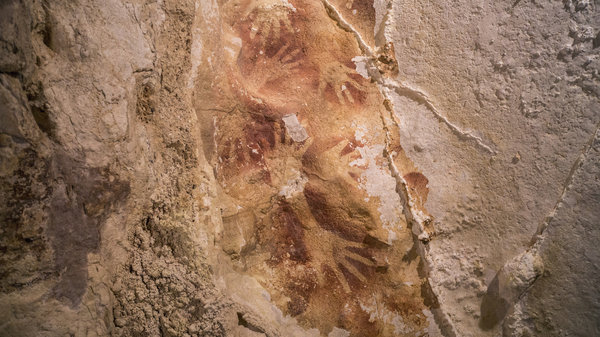(单词翻译:单击)
There is nothing like a blank stone surface to inspire a widely shared urge to make art.
没有什么东西会像空白的石头表面一样,能够激发广泛的艺术创作欲望。
A team of researchers reported in the journal Nature on Wednesday that paintings of hands and animals in seven limestone caves on the Indonesian island of Sulawesi may be as old as the earliest European cave art.
周三(本文最初发表于2014年10月9日),一组科研人员在《自然》杂志(Nature)上发表文章称,印度尼西亚苏拉威西岛七座石灰岩洞中发现的人手及动物图像,可能与欧洲最早的洞穴画一样古老。

The oldest cave painting known until now is a 40,800-year-old red disk from El Castillo, in northern Spain.
目前已知的最古老的洞穴画是西班牙北部卡斯蒂略金字塔中已有4万零800年历史的壁画。
Other archaeologists of human origins said the new findings were spectacular and, in at least one sense, unexpected. Sulawesi’s cave art, first described in the 1950s, had previously been dismissed as no more than 10,000 years old.
其他一些研究人类起源的考古学家表示,这一新发现相当引人注目,而且至少在一种意义上,出乎了人们的意料。20世纪50年代,首次出现了有关苏拉威西岛洞穴画的介绍。科研人员之前认为,这些壁画的历史不超过1万年。
“Assuming that the dates are good,” Nicholas Conard, an archaeologist at the University of Tübingen in Germany, said in an email, “this is good news, and the only surprising thing is not that analogous finds would exist elsewhere, but rather that it has been so hard to find them” until now.
“假设得出的年代准确,”德国蒂宾根大学(University of Tübingen)的考古学家尼古拉斯·科纳尔(Nicholas Conard)在电邮中说,“这是好消息,唯一令人意外的不是会在其他地方找到类似的发现,而是竟然一直都难以找到它们,”直到现在。
Eric Delson, a paleoanthropologist at Lehman College of the City University of New York, agreed that the discovery “certainly makes sense.” Recent genetic findings, he said, “support an early deployment of modern humans eastward to Southeast Asia and Australasia, and so having art of a similar age is reasonable as well.”
纽约城市大学莱曼学院(Lehman College of the City University of New York)的古人类学家埃里克·德尔森(Eric Delson)认同这项发现“无疑很合理”。他表示,最近在基因学上的发现“支持了晚期智人一早向东迁移至东南亚和澳大拉西亚的说法,因此拥有相似年代的美术作品也是合情合理的”。
The authors of the new study, a team from Australia and Indonesia, used a uranium decay technique to date the substance that encrusts the wall paintings — a mineral called calcite, created by water flowing through the limestone in the cave. The art beneath is presumably somewhat older than the crust.
这篇新研究论文的作者是一群来自澳大利亚和印度尼西亚的研究者。他们利用铀衰变技术确定了壁画外层物质的年代。这种名为方解石的矿物由水流过山洞里的石灰石而形成。矿物层下的壁画的年代应该比矿物层本身更久远。
Maxime Aubert and Adam Brumm, research fellows at Griffith University in Queensland, Australia, and the leaders of the study, examined 12 images of human hands and two figurative animal depictions at the cave sites.
澳大利亚昆士兰格里菲斯大学(Griffith University)的两名研究人员马克西姆·奥贝特(Maxime Aubert)和亚当·布鲁姆(Adam Brumm)是团队带头人。他们对洞中12幅人类手部图画及两幅具象动物图画进行了检测。
The researchers said the earliest images, with a minimum age of 39,900 years, are the oldest known stenciled outlines of human hands in the world. Blowing or spraying pigment around a hand pressed against rock surfaces would become a common practice among cave artists down through the ages — and even some of the youngest schoolchildren to this day.
研究人员表示,其中最古老的图画至少有3万9900年的历史,是世界上已知的年代最久远的利用人手模板绘制的轮廓图。将手压到岩石表面,在其周围吹或喷洒颜料成为了后来的洞穴艺术家惯用的手法,甚至到了今天,一些年幼的学生还在使用这个方法。
A painting of an animal known as a pig deer, of the species babirusa, was determined to be at least 35,400 years old. The team concluded that it was “among the earliest dated figurative depiction worldwide, if not the earliest one.”
研究人员确定,一幅鹿豚——一种巴比如萨猪鹿——洞穴画至少有3万5400年的历史。团队认为,这“就算不是世界上最古老的具象图画,也属于最古老的行列”。
The closest in age from Western Europe is a painting of a rhinoceros from Chauvet Cave in France, dated at 35,000 years old, although some archaeologists have questioned that estimate. The most familiar rock art in the region of Sulawesi was created by the Aborigines of Australia, modern humans who arrived there 50,000 years ago. But none of the surviving rock art is older than 30,000 years.
西欧地区与其年代上最接近的图画是法国肖维岩洞的犀牛图。它有3万5000年的历史,但一些考古学家对这一估计表示怀疑。苏拉威西岛地区最为人所熟知的岩石艺术品是由澳大利亚的土著居民创作的。这些晚期智人在大约5万年前到达该地区。不过,现存的岩石艺术品的历史均未超过3万年。
The Sulawesi dates challenge the long-held view about the origins of cave art in an explosion of human creativity centered on Western Europe about 40,000 years ago, Dr. Aubert said, in an announcement issued by Griffith University.
在格里菲斯大学发表的声明中,奥贝特博士表示,苏拉威西岛画作的年代对长期以来有关洞穴艺术起源的观点形成挑战。传统观念认为,人类创造力大爆发的现象以大约4万年前的西欧地区为中心,并由此产生了洞穴艺术。
Instead, he said, the creative brilliance required to produce the lifelike portrayals of horses and other animals much later at famous sites like Chauvet and Lascaux in France could have particularly deep roots within the human lineage.
他表示,与这种学说相反,很久以后法国肖维岩洞和拉斯科洞穴等著名古迹里出现的那种栩栩如生的马等动物的图像,所需要的创意才华可能深深扎根于人类血统中。
But it is too soon to assess the discovery’s deeper implications, Wil Roebroeks, a specialist in human origins studies at Leiden University in the Netherlands, wrote in a commentary accompanying the report. “Whether rock art was an integral part of the cultural repertoire of colonizing modern humans, from Western Europe to southeast and beyond, or whether such practices developed independently in various regions, is unknown,” he wrote.
荷兰莱顿大学(Leiden University)研究人类起源的专家维尔·罗伯罗伊克兹(Wil Roebroeks)在与论文同时发表的评论中写道,现在评估这项发现的深层含义还为时过早。“目前尚不清楚,岩石艺术究竟是从西欧迁移到东南部及更远的地方的晚期智人创造的文化技能的内在组成部分,还是在各个地区得到了单独发展,”他写道。
“But what is clear,” Dr. Roebroeks continued, “is that no figurative art is known from before the time of the initial expansion of Homo sapiens into Asia and across Europe — neither from earlier H. sapiens in Africa nor from their contemporaries in western Eurasia, the Neanderthals.”
“但已经明确的是,”罗伯罗伊克兹博士继续写道,“还没有发现智人最初向亚洲及在欧洲各地迁徙前出现的具象艺术,也没有发现早期非洲智人或欧亚大陆西部同时代人类——尼安德特人——时期的具象艺术。”
Dr. Conard, of Tübingen University, said he had long argued for what he calls polycentric mosaic modernity, in which similar kinds of cultural innovations happened in different contexts as modern Homo sapiens spread across the world and displaced archaic hominins.
德国蒂宾根大学的科纳尔博士表示,他早就提出了“多中心融合发展”的学说:随着晚期智人扩散至世界各地,取代早期智人,不同的地方出现了类似的文化创新活动。
“I have never thought that complex symbolic behavior has a single point source and that cultural evolutions is like switching a light on,’” he said. “One would expect different regions to have distinctive signatures and to contribute to the story in their own way.”
“我从不认为,复杂的象征性行为有一个单一的源头,也不认为文化进化就像关上灯的开关一样,”他说。“应该认为不同的地区有各自的特征,以自己不同的方式共同为历史贡献力量。”
Dr. Delson, of CUNY, said he tended “to prefer the idea that art came as part of the ’baggage’ of Homo sapiens as they spread into Eurasia, mainly as we know that so many of the cultural features once thought to have developed in western Eurasia in fact occurred far earlier in Africa.”
纽约城市大学的德尔森博士则表示,他往往“倾向于这种想法,即艺术是智人扩散到欧亚大陆时携带的'行李'的一部分。这主要是因为,众所周知,那些曾被认为起源于欧亚大陆西部的文化现象实际上很早以前就出现在非洲。”
He cited the examples of early use of pigments and engravings in Africa, as well as bodily adornment with shells and advanced stoneworking technology.
他提到的例子包括,非洲的人类早早使用颜料、进行雕刻、用贝壳装饰身体,还拥有先进的砌石工艺。
In their report, Dr. Aubert and Dr. Brumm took no sides in the debate. “It is possible that rock art emerged independently around the same time and at roughly both ends of the spatial distribution of early modern humans,” they concluded. “An alternate scenario, however, is that cave painting was widely practiced by the first H. sapiens to leave Africa tens of thousands of years earlier.”
在论文中,奥贝特和布鲁姆对这一争论持中立态度。“岩石艺术有可能同时在早期智人分布地区的两端独立出现,”他们在结论部分这样写道。“然而,也可能是另一种情况,即再往前数万年,第一批离开非洲的智人广泛进行洞穴画创作。”
If that is the case, the Australian-Indonesian research team predicted, “We can expect future discoveries of depictions of human hands, figurative art and other forms of image-making dating to the earliest period of the global dispersal of our species.”
如果事实的确如此,澳大利亚和印度尼西亚的联合研究小组预测,“我们可以期待未来会发现人手图画、具象艺术,以及能够追溯到人类最早向全球扩散时期的其他一些成像艺术形式。”


